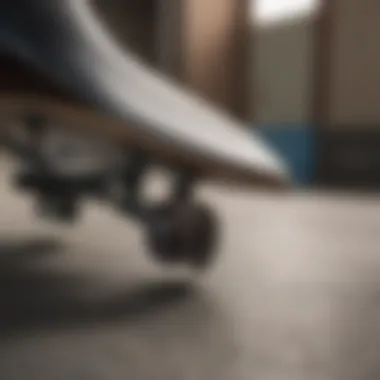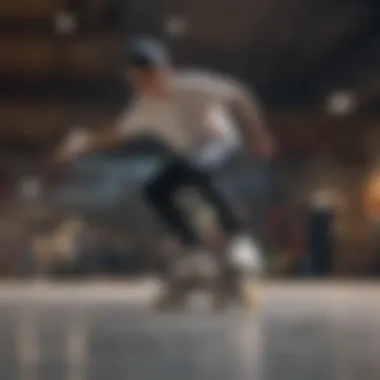Mastering the Art of Step Skating: A Complete Guide to Skate Blade Mastery


Skateboarding News Updates
When it comes to mastering skate blades, staying updated on skateboarding news is crucial for enthusiasts looking to enhance their skills. Keeping abreast of the latest skate competitions, new product launches, and upcoming skateboarding events can provide valuable insights into the evolving landscape of the sport. Whether it's recapping thrilling skate competitions, exploring innovative product releases, or immersing in the vibrant atmosphere of skateboarding events, staying informed is key to remaining at the forefront of the skating scene.
Trick Tutorials and Guides
Delving into the realm of trick tutorials and guides is essential for skaters eager to advance their skills. From breaking down beginner tricks to offering tips on mastering advanced maneuvers, this section serves as a comprehensive resource for skaters of all levels. Whether you're looking to perfect freestyle moves or master street skate techniques, detailed tutorials and guides provide step-by-step instructions and valuable insights to help you elevate your skateboarding proficiency.
Skateboarding Culture and Lifestyle
Skateboarding is not just a sport but a lifestyle that encompasses a vibrant culture celebrated by enthusiasts worldwide. Through influencer spotlights, skatepark reviews, and insights into the latest skateboarding fashion trends, this section delves into the multifaceted world of skateboarding culture. By shining a light on key influencers, exploring the nuances of different skateparks, and uncovering emerging fashion trends, readers gain a deeper appreciation for the rich tapestry of skateboarding's cultural impact.
Gear Reviews and Recommendations
Selecting the right gear is paramount in optimizing your skateboarding experience, from decks to trucks and wheels. In this section, readers can find in-depth reviews of skateboard decks, comparisons of various truck and wheel options, and suggestions for protective gear. By offering detailed analyses and recommendations, skaters can make informed decisions when it comes to choosing equipment that aligns with their preferences and enhances their performance on the board.
Healthy Lifestyle for Skaters
Maintaining a healthy lifestyle is integral to supporting longevity and peak performance in skateboarding. This section explores essential injury prevention exercises, outlines tailored fitness and strength training routines for skaters, and provides nutritious tips to fuel your body for optimal performance. By prioritizing health and well-being, skaters can enhance their physical resilience, endurance, and overall enjoyment of the sport.
Introduction to Step Skating
In delving into the realm of step skating, we embark on a journey that goes beyond mere gliding on ice. Understanding the nuances of step skating is crucial for both novice and experienced skaters looking to elevate their skills. This section serves as a foundation, laying the groundwork for exploring the intricacies of balancing, gliding, and maneuvering on skate blades. From the physics of motion to the artistry of footwork, step skating encompasses a wide array of techniques and disciplines that are central to mastering the sport.
Understanding the Basics
History of Step Skating
Exploring the historical roots of step skating reveals a rich tapestry of innovation and cultural significance. From its origins in traditional ice sports to its evolution into a competitive discipline, the history of step skating offers valuable insights into the art form. Understanding the genesis of step skating provides skaters with a deeper appreciation for the craft, enabling them to draw inspiration from the pioneers who paved the way. Delving into historical contexts sheds light on the influences that have shaped modern step skating techniques, highlighting the enduring legacy of this timeless sport.
Benefits of Step Skating
Unveiling the myriad benefits of step skating unveils a world of physical, mental, and emotional advantages. From enhanced balance and coordination to improved cardiovascular health, the rewards of step skating are both tangible and profound. Engaging in this dynamic sport not only strengthens the body but also sharpens the mind, fostering discipline and resilience. Embracing the challenges of step skating leads to personal growth and a sense of accomplishment, making it a holistic and gratifying pursuit for individuals of all ages and skill levels.
Key Equipment Needed
The significance of having the right equipment for step skating cannot be overstated. From skate blades to protective gear, each component plays a crucial role in ensuring safety and performance on the ice. Understanding the key equipment needed for step skating involves familiarizing oneself with the various types of skate blades, their profiles, and customization options. Proper sizing and fitting of equipment are essential to prevent injuries and optimize skater comfort. Investing in high-quality gear is paramount for experiencing the full range of benefits that step skating has to offer.


Essential Techniques
Balancing on Skate Blades
Mastering the art of balancing on skate blades is a fundamental skill that forms the cornerstone of step skating proficiency. Achieving stability on the ice requires a blend of core strength, precise footwork, and mental focus. By developing a keen sense of body awareness and weight distribution, skaters can navigate the rink with grace and confidence. Balancing on skate blades not only enhances physical agility but also cultivates a deep connection between the skater and the ice, opening up possibilities for fluid movement and creative expression.
Mastering Forward Stride
Perfecting the forward stride is essential for propelling oneself across the ice with speed and efficiency. By mastering the mechanics of the forward push-off, skaters can glide effortlessly and maintain momentum on straightaways. Executing proper body positioning and leg extension is key to maximizing the power generated from each stride. Through continuous practice and refinement, skaters can fine-tune their technique and achieve a seamless, fluid motion that defines the essence of step skating.
Perfecting Crossovers
Crossovers are dynamic maneuvers that require skill, agility, and coordination to execute smoothly. By mastering the art of crossing one foot over the other while maintaining momentum, skaters can navigate turns with precision and elegance. Perfecting crossovers involves coordinating upper and lower body movements, engaging core muscles, and shifting weight strategically. This advanced technique not only adds flair to a skater's repertoire but also enhances control and maneuverability on the ice, opening up new possibilities for creative expression and performance excellence.
Advanced Step Skating Maneuvers
Step skating reaches its pinnacle with advanced maneuvers, elevating skaters' skills to unparalleled levels of finesse and precision. This section delves into the intricacies of pushing the boundaries of athleticism on ice, highlighting the technical mastery required to execute flawless moves. From edge control to jumping techniques, the journey into advanced step skating maneuvers is a testament to relentless practice and dedication.
Edge Control and Turns
Inside and Outside Edges
In the realm of step skating, mastering inside and outside edges is akin to honing the foundation of one's prowess on ice. These edges play a pivotal role in executing fluid transitions and sharp turns, fundamental elements in showcasing agility and control. With an emphasis on weight distribution and blade positioning, skaters harness the power of inside and outside edges to maneuver effortlessly across the rink, embodying grace and sophistication in their movements.
Transitioning Between Turns
Transitioning between turns represents a seamless flow of movement, underscoring the grace and fluidity essential in advanced step skating. This skill demands a keen eye for footwork precision and timing, allowing skaters to navigate complex sequences with poise and accuracy. Meticulous attention to detail in shifting weight distribution ensures interconnectivity between maneuvers, culminating in a harmonious display of technical acumen on the ice.
Executing Tight Turns
The art of executing tight turns epitomizes the epitome of agility and nimbleness in step skating. Tight turns require a delicate balance of speed, edge control, and body positioning to execute swift, precise rotations with finesse. Skaters hone their ability to generate centrifugal force, enabling them to navigate tight spaces with ease and elegance, pushing the boundaries of their technical prowess in pursuit of perfection.
Jumping Techniques
Axels and Toe Jumps
Axels and toe jumps serve as the pinnacle of aerial artistry in step skating, showcasing the fusion of power and grace in mid-air maneuvers. These jumps demand explosive strength and impeccable timing, culminating in breathtaking displays of athleticism and precision. Skaters master the art of rotational dynamics, defying gravity with each twist and turn, captivating audiences with their airborne acrobatics.
Mastering Spins


Mastering spins embodies the essence of finesse and precision, requiring skaters to showcase unparalleled control and balance in seamless rotations. Spins showcase skaters' artistry and technical proficiency, intertwining athleticism with art as they execute intricate spin variations with seamless transitions. By channeling momentum and core strength, skaters achieve mesmerizing spin sequences that mesmerize spectators and judges alike.
Combination Jumps
Combination jumps represent the apex of technical skill and artistry in step skating, challenging skaters to seamlessly fuse multiple jumps into a cohesive sequence. These jumps require a harmonious blend of power, timing, and precision to execute interconnected aerial feats with flawless execution. Skaters push the boundaries of innovation by choreographing intricate jump sequences that captivate audiences and elevate their performances to unprecedented levels of creativity and complexity.
Incorporating Footwork
Artistry in Step Skating
Artistry in step skating transcends mere technical proficiency, encompassing an emotional expression and storytelling through nuanced footwork sequences. Skaters infuse their performances with individual flair and creativity, capturing the audience's imagination through intricate footwork patterns that evoke mood and sensation. Artistry in step skating is a catalyst for a deeper connection between skaters and spectators, shaping memorable performances that linger in the hearts and minds of the audience.
Footwork Sequences
Footwork sequences serve as the artistic heartbeat of step skating, weaving together a tapestry of movement and emotion in a fluid display of skill and creativity. Skaters craft elaborate footwork sequences that showcase their versatility and interpretive prowess, transforming the ice into a canvas of expression. Each step and glide is imbued with purpose and intent, connecting with the audience on a visceral level and leaving an indelible mark long after the performance concludes.
Choreographing Routines
Choreographing routines is a multifaceted endeavor that entails conceptualizing music, movement, and emotion to create a cohesive performance that resonates with the audience. Skaters collaborate with choreographers to develop routines that showcase their strengths and artistry, culminating in a harmonious fusion of athleticism and expression. Choreographing routines elevates step skating beyond mere technical proficiency, transforming it into a captivating art form that transcends boundaries and inspires awe in all who witness its beauty.
Equipment and Maintenance
When delving into the world of step skating mastery, one cannot underestimate the significance of equipment and maintenance. The foundation of a successful skating experience lies in selecting the right skate blades and ensuring their proper upkeep. By focusing on the specific elements of equipment and maintenance, skaters can enhance their performance and prolong the lifespan of their gear. An essential aspect is aligning the skate blades with the skater's level of expertise and personal preferences. Proper maintenance not only ensures smooth gliding on ice but also minimizes the risk of accidents due to wear and tear.
Choosing the Right Skate Blades
Blade Types and Profiles
In the realm of choosing the right skate blades, the consideration of blade types and profiles plays a pivotal role. Different blade types offer varying levels of stability, agility, and control, catering to skaters' diverse needs. Selecting the appropriate blade profile can significantly impact the skater's maneuverability and speed on the ice. Understanding the key characteristics of blade types and profiles empowers skaters to make informed decisions that align with their skill level and performance goals. While certain blade types may excel in providing enhanced precision during intricate routines, others focus on stability for beginners. It is crucial to weigh the advantages and disadvantages of each blade type to maximize skating efficiency.
Customization Options
The realm of customization options for skate blades opens up a plethora of possibilities for skaters seeking optimal performance. Customization allows skaters to tailor their blades to suit their individual preferences and skating styles. Embracing customization options enhances skaters' comfort and confidence on the ice by adjusting factors such as blade curvature and radius to align with their technique and skill level. Choosing customized options that complement skating proficiency can elevate the overall experience, providing a competitive edge and better control over maneuvers.
Proper Sizing and Fitting
Proper sizing and fitting are fundamental aspects of ensuring optimal performance and safety on the ice. Ill-fitting skates can lead to discomfort, blisters, and hindered mobility, affecting the skater's precision and confidence. By emphasizing proper sizing and fitting, skaters can prevent injuries and enhance their on-ice performance. Selecting skates that offer a snug yet comfortable fit ensures stability and agility during complex maneuvers, allowing skaters to focus on honing their skills without distractions. Attention to details such as sizing ensures a seamless connection between the skater and the ice surface, facilitating fluid movements and precise control.


Skate Blade Care Tips
Sharpening Techniques
Effective skate blade maintenance encompasses sharpening techniques aimed at optimizing blade performance on the ice. Sharpening ensures blade edges are keen, promoting smooth gliding and precise turns during skating routines. Skaters must adopt appropriate sharpening techniques based on their skill level and frequency of use to maintain blade sharpness. Understanding the key characteristics of sharpening techniques guides skaters in preserving blade integrity and maximizing skating efficiency.
Blade Alignment
Blade alignment is a critical aspect of skate blade care that directly influences stability and control during skating maneuvers. Properly aligned blades facilitate effortless gliding and precise edge control, enabling skaters to execute complex routines with confidence. Skaters must pay attention to blade alignment to avoid imbalance or slippage, which can compromise performance on the ice. Aligning blades for optimal contact with the ice surface enhances maneuverability and overall skating experience.
Storage Recommendations
Preserving skate blades in top condition involves adhering to appropriate storage recommendations. Proper storage practices protect blades from oxidation and damage, ensuring longevity and performance consistency. Skaters should store their blades in a cool, dry environment to prevent rust and maintain blade sharpness. Implementing effective storage recommendations safeguards blades from premature wear and tear, extending their usability and enhancing on-ice performance.
Training and Progression
In the realm of mastering skate blades, the topic of Training and Progression serves as a crucial pillar for skaters at all levels. This section delves into the significance of honing one's skills off the ice to enhance on-ice performance. Training and Progression encompass a spectrum of elements from building strength and endurance to skill development strategies, all aimed at refining the art of step skating.
Building Strength and Endurance
Off-Ice Exercises
Off-Ice Exercises constitute a fundamental aspect of a skater's regimen, offering a diverse range of benefits beyond traditional on-ice practices. These exercises play a pivotal role in improving muscle strength, balance, and flexibility required for executing complex maneuvers on the ice. Skaters engage in off-ice exercises to enhance their overall athletic performance, prevent injuries, and augment their on-ice proficiency. Despite being a time-tested method to strengthen foundational skills, these exercises require consistency and dedication to yield optimal results.
Cardiovascular Fitness
Cardiovascular Fitness stands as a cornerstone in a skater's training routine, fostering endurance and cardiovascular health essential for enduring rigorous routines and performances. Skaters emphasize cardiovascular training to improve stamina, regulate breathing patterns, and enhance overall physical conditioning. An effective cardiovascular fitness regimen complements on-ice practices, facilitating sustained energy levels and enhanced recovery post-training. However, skaters must strike a balance between cardiovascular workouts and skill-focused training to ensure holistic development and peak performance.
Muscle Conditioning
Muscle Conditioning plays a pivotal role in enhancing a skater's strength, agility, and explosiveness necessary for executing precise movements on the ice. By engaging in targeted muscle conditioning exercises, skaters can fortify specific muscle groups essential for performing jumps, spins, and intricate footwork. Incorporating muscle conditioning routines into training programs helps skaters build power, endurance, and muscular symmetry crucial for achieving technical proficiency in step skating. However, skaters must pay heed to proper form, progression, and recovery protocols to prevent muscle imbalances and injuries, underscoring the meticulous approach required in muscle conditioning practices.
Skill Development Strategies
Practice Routines
Practice Routines hold a distinct significance in a skater's journey, offering structured sessions to refine techniques, enhance consistency, and foster muscle memory. Skaters rely on practice routines to simulate competition scenarios, troubleshoot technical challenges, and elevate their performance levels. These routines enable skaters to focus on specific aspects of their skating repertoire, improve timing and precision, and cultivate a disciplined training ethic. While practice routines are instrumental in skill enhancement, skaters must approach each session with intention, resilience, and a growth-oriented mindset to maximize their training outcomes.
Professional Coaching
Professional Coaching emerges as a transformative element in a skater's development, providing personalized guidance, expert feedback, and strategic training plans tailored to individual strengths and areas of improvement. Skaters enlist professional coaches to refine their technique, instill competitive strategies, and navigate the intricacies of elite-level performance. A skilled coach not only enhances a skater's technical proficiency but also nurtures mental resilience, goal-setting abilities, and competitive edge. However, skaters must actively engage with their coaches, embrace feedback constructively, and commit to continuous learning to leverage the full potential of professional coaching relationships.
Competition Preparation
Competition Preparation stands as a cornerstone in a skater's journey, necessitating meticulous planning, mental fortitude, and peak physical condition to deliver exceptional performances on the ice. Skaters dedicate substantial time and effort to prepare for competitions, strategizing routines, refining choreography, and fine-tuning technical elements. Beyond physical preparedness, skaters focus on mental preparation, visualizations, and stress management techniques to mitigate performance anxiety and optimize competitive readiness. Empowered by comprehensive preparation, skaters step onto the ice equipped with confidence, poise, and a competitive spirit, poised to showcase their skills and artistry to the discerning eyes of judges and spectators.







